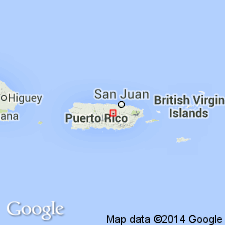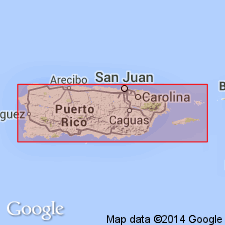
- Usage in publication:
-
- Cibuco Formation*
- Modifications:
-
- Named
- Dominant lithology:
-
- Conglomerate
- Volcanics
- AAPG geologic province:
-
- Caribbean region
Summary:
The Cibuco Formation, here named, consists of massive conglomerate in the lower part grading upward into thinner bedded conglomerate and volcanic clastic rocks. Lower contact is hidden by faulting; underlies and interfingers with lower beds of the Carreras Siltstone. Age is same as Carreras, Late Cretaceous or early Tertiary.
Source: GNU records (USGS DDS-6; Reston GNULEX).

- Usage in publication:
-
- Cibuco Formation*
- Modifications:
-
- Overview
- AAPG geologic province:
-
- Caribbean region
Summary:
The Cibuco Formation occurs in central Puerto Rico and consists of conglomerate with interbedded volcanic sandstone, siltstone, and tuff. Maximum known thickness is 2000 meters. The Cibuco is of Late Cretaceous(?) and Paleogene(?) age.
Source: GNU records (USGS DDS-6; Reston GNULEX).
For more information, please contact Nancy Stamm, Geologic Names Committee Secretary.
Asterisk (*) indicates published by U.S. Geological Survey authors.
"No current usage" (†) implies that a name has been abandoned or has fallen into disuse. Former usage and, if known, replacement name given in parentheses ( ).
Slash (/) indicates name conflicts with nomenclatural guidelines (CSN, 1933; ACSN, 1961, 1970; NACSN, 1983, 2005, 2021). May be explained within brackets ([ ]).

